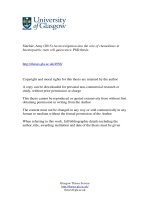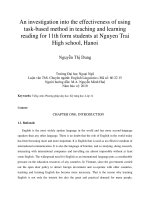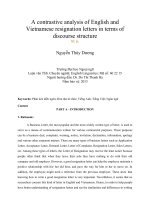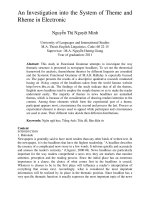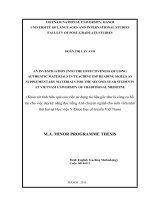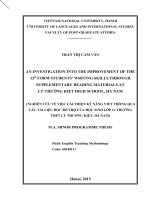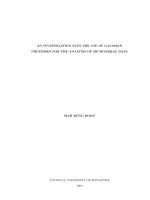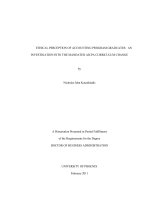An investigation into the use of modality as a rhetorical device in President Barack Obamas State of the Union address in 2016
Bạn đang xem bản rút gọn của tài liệu. Xem và tải ngay bản đầy đủ của tài liệu tại đây (1.05 MB, 104 trang )
TRẦN MINH ĐỨC
VIETNAM ACADEMY OF SOCIAL SCIENCES
GRADUATE ACADEMY OF SOCIAL SCIENCES
Trần Minh Đức
ENGLISH LANGUAGE
AN INVESTIGATION INTO THE USE OF
MODALITY AS A RHETORICAL DEVICE IN
PRESIDENT BARACK OBAMA’S STATE OF
THE UNION ADDRESS IN 2016
MA THESIS IN ENGLISH LANGUAGE
COURSE: 2016 – 2018
DECLARATION BY AUTHOR
HANOI, 2018
VIETNAM ACADEMY OF SOCIAL SCIENCES
GRADUATE ACADEMY OF SOCIAL SCIENCES
Trần Minh Đức
AN INVESTIGATION INTO THE USE OF
MODALITY AS A RHETORICAL DEVICE IN
PRESIDENT BARACK OBAMA’S STATE OF
THE UNION ADDRESS IN 2016
Field: English Language
Code: 8220201
Supervisor: Assoc. Prof. Dr. Hồ Ngọc Trung
HANOI, 2018
DECLARATION BY AUTHOR
I hereby declare that this thesis, entitled “An Investigation into the Use
of Modality as a Rhetorical Device in President Barack Obama’s State of the
Union Address in 2016” has not been submitted as an exercise for a degree at
this or any other universities. This paper is the result of my own original
research and, to the best of my knowledge and belief, contains no material
previously published or written by another person, except where due
reference has been made in the text.
Author’s Signature
Trần Minh Đức
Approved by
SUPERVISOR
Assoc. Prof. Dr. Hồ Ngọc Trung
Date: 15/3/2018
i
ACKNOWLEDGEMENTS
In completing this thesis, I owe a deep debt of gratitude to my
supervisor, Assoc. Prof. Dr. Ho Ngoc Trung. I thank him for his profound
knowledge, encouragement, support and patience. Without his whole-hearted
guidance, insightful comments and recommendations, this thesis would not
have been possible.
My sincere thanks also go to my instructor, Dr. Dang Nguyen Giang,
Dean of the Faculty of Foreign Languages, Graduate Academy of Social
Sciences, whose lectures have inspired me to the foundation of the thesis.
Moreover, I would like to thank all of the lecturers who gave me interesting
lessons and dedication.
Finally, I must express my gratitude to my family. It is their endless
love and expectations that have motivated me to complete this thesis.
ii
TABLE OF CONTENTS
Page
DECLARATION BY AUTHOR ....................................................................... i
ACKNOWLEDGEMENTS .............................................................................. ii
ABSTRACT .................................................................................................... vii
LIST OF TABLES ......................................................................................... viii
CHAPTER 1: INTRODUCTION.................................................................. 1
1.1. Rationale .................................................................................................... 1
1.2. Aims of the Study ...................................................................................... 2
1.3. Research Questions .................................................................................... 2
1.4. Scope of the Study ..................................................................................... 2
1.5. Significance of the Study ........................................................................... 2
1.5.1. Theoretical Significance of the Study ..................................................... 2
1.5.2. Practical Significance of the Study ......................................................... 3
1.6. Methodology .............................................................................................. 3
1.6.1. Methods of the Study .............................................................................. 3
1.6.2. Data Collection ....................................................................................... 4
1.6.3. Data Description and Analysis ............................................................... 4
1.7. Structure of the Study ................................................................................ 5
CHAPTER 2: LITERATURE REVIEW ..................................................... 7
2.1. Previous Studies ......................................................................................... 7
2.2. The Concept of Modality ........................................................................... 9
2.2.1. Definitions of Modality........................................................................... 9
iii
2.2.2. Types of Modality ................................................................................. 13
2.2.2.1. Epistemic Modality (Extrinsic) .......................................................... 13
2.2.2.2. Deontic Modality (Intrinsic) .............................................................. 14
2.2.2.3. Modal Expressions ............................................................................. 15
2.3 Politics and Political Speeches.................................................................. 21
2.3.1. Politics ................................................................................................... 21
2.3.2. Political Speech as a Type of Discourse ............................................... 22
2.3.3. Political Speech as a Type of Public Speaking ..................................... 22
2.4. Rhetorical Devices in Political Speeches................................................. 23
2.4.1. Rhetoric ................................................................................................. 23
2.4.2. Rhetorical Devices ................................................................................ 24
2.4.3. Modality as a Rhetorical Device ........................................................... 24
2.5. Barack Obama as the 44th US President .................................................. 25
2.5.1. An Introduction of President Barack Obama ........................................ 25
2.5.2. An Introduction of Barack Obama’s State of the Union Address in 2016
......................................................................................................................... 26
2.6. Summary .................................................................................................. 27
CHAPTER 3: TYPES OF MODALITY USED IN PRESIDENT
OBAMA’S STATE OF THE UNION ADDRESS IN 2016 ....................... 30
3.1. Types of Modality Markers used in President Obama’s 2016 State of the
Union Address................................................................................................. 30
3.1.1. Modal Auxiliaries ................................................................................. 30
3.1.2. Modal Lexical Verbs............................................................................. 33
3.1.3. Modal Adverbs...................................................................................... 33
iv
3.1.4. Modal Adjectives .................................................................................. 33
3.2. Distribution of Modality Markers used in President Obama’s 2016 State
of the Union Address ...................................................................................... 34
3.3. Summary .................................................................................................. 37
CHAPTER 4: MODALITY AS A RHETORICAL DEVICE .................. 38
4.1. Modal Auxiliaries as a Rhetorical Device ............................................... 38
4.1.1. The Modal Auxiliary Will (not) ............................................................ 38
4.1.1.1. Volition (Intrinsic) ............................................................................. 39
4.1.1.2. Prediction (Extrinsic) ......................................................................... 40
4.1.2. Modal Auxiliary Can (not) ................................................................... 41
4.1.2.1. Possibility (Extrinsic)......................................................................... 42
4.1.2.2. Ability (Extrinsic) .............................................................................. 43
4.1.3. The modal Auxiliary Might .................................................................. 44
4.1.4. The Modal Auxiliary Could .................................................................. 46
4.1.4.1. Possibility (Extrinsic)......................................................................... 46
4.1.4.2. Ability (Extrinsic) ............................................................................. 47
4.1.5. The Modal Auxiliary Should ............................................................... 47
4.1.5.1. Obligation (Intrinsic) ......................................................................... 48
4.1.5.2. Necessity (Extrinsic) ......................................................................... 49
4.1.6. The Modal Auxiliary Need .................................................................. 50
4.1.6.1. Obligation (Intrinsic) ......................................................................... 51
4.1.6.2. Necessity (Extrinsic) ......................................................................... 52
4.1.7. The Modal Auxiliary Have to .............................................................. 53
v
4.1.7.1. Obligation (Intrinsic) ......................................................................... 53
4.1.7.2. Necessity (Extrinsic) ......................................................................... 54
4.1.8. The Modal Auxiliary May .................................................................... 55
4.1.8.1. Possibility (Extrinsic)......................................................................... 55
4.1.9. The Modal Auxiliary Would ................................................................. 56
4.1.9.1. Volition (Intrinsic) ............................................................................. 57
4.2. Modal Lexical Verbs as Rhetorical Device ............................................. 57
4.2.1. The First-Person Epistemic Phrase I Know .......................................... 58
4.2.2. The First-Person Epistemic Phrase I Believe (in) ................................. 58
4.2.3. The First-Person Epistemic Phrase I Think ......................................... 60
4.2.4. The First-Person Epistemic Phrase I Understand ............................... 61
4.3. The Modal Adverb as a Rhetorical Device ............................................ 62
4.4. The Modal Adjectives as a Rhetorical Device ....................................... 62
4.5. Summary .................................................................................................. 64
CHAPTER 5: CONCLUSION..................................................................... 65
5.1. Recapitulation .......................................................................................... 65
5.2. Concluding Remarks ................................................................................ 66
5.3. Implications .............................................................................................. 68
5.4. Limitations and Suggestions for Further Studies ..................................... 69
REFERENCES .............................................................................................. 71
APPENDIX: The President Barack Obama’s State of the Union Address
in 2016 ....................................................................................... I
vi
ABSTRACT
Modality in political discourse has interested linguistic researchers
around the world to a great extent. The study aims at analysing how modality
in the speech is used as a rhetorical device. All the data is collected from the
speech. Quantitative and qualitative methods are employed to have analysis
on the data. It is carried out on the ground of the theories written by Quirk et
al. (1985), Van Linden (2012) and Wierzbicka(2006) that help the author
mainly find out the use of modality as a rhetorical device in a political speech.
The State of the Union Address in 2016 delivered by the President Barack
Obama is investigated. Firstly, the study focuses on the analysis on the
occurrence percentage of some types of modality markers. Secondly, the
paper mainly aims at analysing modality in the speech used as a rhetorical
device. Besides, some of the grammatical, syntactic and semantic features of
modality are also referred to which make great contributions to illustrate that
modality in the President Barack Obama’s 2016 State of the Union Addressis
treated as a rhetorical device.
vii
LIST OF TABLES
Page
Table 2.1: The auxiliary verb-main verb scale - Quirk et al. (1985) ........... 16
Table 2.2: Potential expressions of modality by central modals – Quirk et al.
(1985) .......................................................................................... 17
Table 2.3: Meaning of the modals – Quirk et al. (1985) ............................. 18
Table 2.4: Common epistemic adverbs in English ...................................... 20
Table 3.1: Occurrences of types of modality markers in the address .......... 34
Table 3.2: Distribution of modal auxiliaries in the address ......................... 36
Table 3.3: Distribution of modal lexical verbs in the address ..................... 36
Table 3.4: Distribution of modal adverbs in the address ............................. 37
Table 3.5: Distribution of modal adjectives in the address ......................... 37
Table 4.1: Categorization of will in the address .......................................... 39
Table 4.2: Categorization of Can in the address .......................................... 41
Table 4.3: Categorization of Might in the address ...................................... 44
Table 4.4: Categorization of Could in the address ...................................... 46
Table 4.5: Categorization of Should in the address ..................................... 48
Table 4.6: Categorization of Need in the address ........................................ 50
Table 4.7: Categorization of Have to in the address .................................... 53
Table 4.8: Categorization of May in the address ......................................... 55
Table 4.9: Categorization of Would in the address ..................................... 57
viii
CHAPTER 1: INTRODUCTION
1.1. Rationale
Language which plays a crucial role in the development of humanbeings and every society is defined as a means of exchanging and transferring
information to readers or listeners in the most effective way. Therefore, we
cannot live without language because of its indispensable effects on every
field of our lives.
Providing information with the use of language depends on a wide
range of factors, especially in written language. How to express points of
view or opinions most effectively is of great importance which may influence
or decide the effectiveness of the information given to the audience or
readers. That is the reason why language empowers men to control or manage
the society. In order to utilize the language in the best way, one of the factors
which is usually applied is how to put rhetorical devices into language,
especially political speeches delivered by politicians.
Politicians are the ones who usually make use of verbal language as a
political tool to get more power. They often deliver their addresses in order to
convince or persuade their audience to agree with their policies or decisions
and so on. Therefore, they always use a number of methods to gain their
purposes. And the use of rhetorical devices as a convincing tool is found in
political speeches.
Modality defined as a term of expressing possibility and necessity
which is used in verbal language is also considered to be a tool to make
clearer about the speaker’s points of view or thoughts. In order to have more
understanding of the effectiveness of the use of modality as a rhetorical
device in political speeches, I would like to choose “An investigation into the
use of modality as a rhetorical device in President Barack Obama’ State of the
1
Union Address in 2016” as my study.
1.2. Aims of the Study
This study aims to investigate and analyze the linguistic features of
modality in the State of the Union address delivered by the US former
President Barack Obama in 2016, and it also provides the readers with the
knowledge of the use of modality as a rhetorical device in order to have more
insights into political speeches when reading them. The research is expected
to fulfill the following objectives:
(i)
Exploring types of modality used in President Obama’s State of
the Union Address in 2016;
(ii)
Investigating how modality is used as a rhetorical device in
President Obama’s State of the Union Address in 2016.
1.3. Research Questions
The thesis is going to answer the following research questions:
1)
What types of modality are used in President Obama’s State of
the Union Address in 2016?
2)
How is modality used as a rhetorical device in President
Obama’s State of the Union Address in 2016?
1.4. Scope of the Study
This thesis has some investigation and analysis on only modal
expressions used in Obama’s State of the Union address in 2016. The study
also focuses on finding and dealing with grammatical and lexical means of
modal expressions. All the data on modality is collected from the address.
1.5. Significance of the Study
1.5.1. Theoretical Significance of the Study
The study hopes to make a remarkable contribution to the investigation
into the use of modality as a rhetorical device in political addresses in general.
2
Moreover, it also helps the readers know the contributions of the use of
modality to the success of the State of the Union Address in 2016 by the US
former President Obama in particular. On the other hand, this paper wishes to
contribute to providing important insights into linguistic features of modality
utilized in the 2016 State of the Union Address as well as political speeches.
1.5.2. Practical Significance of the Study
The study wishes:
- to provide the readers with the systematic description and
analysis on the effectiveness of the use of modality in President Barack
Obama’s 2016 State of the Union Address;
- to provide the readers in general, the students of English in
particular, with the knowledge of modality as a rhetorical device in political
speeches;
- to assist writers, especially students of English, know how to
use modality in their writings in an effective way.
- to provide the author with the overview of modality used in
political speeches delivered by Barack Obama which can help the author do
more research on contrastive analysis on modality as a rhetorical device
between English and Vietnamese later.
1.6. Methodology
1.6.1. Methods of the Study
This is a descriptive study. So, the aim of the study is to collect the data
concerning modality in the speech, and then analyse it to find the
effectiveness of the use of modality as a rhetorical device in a political
address. Therefore, the principal methods applied for the study are
quantitative and qualitative methods. The former is defined as the use of
numbers as its basis for making generalizations about a phenomenon; and the
3
latter is used to gain an understanding of underlying reasons, opinions, and
motivations. It provides insights into the problems or helps to develop ideas
or hypotheses for potential quantitative research.
The data will serve as the basis for explaining the use of modality;
therefore, it can be gathered through data collection. The data will then be
analyzed using the theoretical framework built by Quirk et al. (2005), Van
Linden (2012) and Wierzbicka’s theory (2006), to unravel significant
relationships or differences between variables. The output serves as the basis
for making the conclusions and generalizations of the study.
1.6.2. Data Collection
The material for research is The President Barack Obama’s 2016 State
of the Union Address which is taken from the Internet. Linguistic forms and
modal characteristics given to denote the modality would take the main
interests in the study. All the data including modal auxiliaries, modal adverbs,
modal adjectives, modal lexical verbs from Obama’s State of the Union
speech in 2016 is collected to meet the criteria for the purpose of investigating
modality in the speech. And then, the data is put into tables categorized
according to kinds of linguistic features of modality for analysis later.
1.6.3. Data Description and Analysis
Quantitative method is the main tool to describe and synthesize the
data. To be more precise, the address will be counted as a collection of
clauses containing modal features. By examining all of the clauses in the
speech, the number of modality expressions is measured, categorised and
totalized. Based on the findings, how modality is expressed and implied in the
address will be revealed with the qualitative method. In other words, the
qualitative method is carried out in analysing the data in the research to find
out or indicate the effectiveness of the use of modality as a rhetorical device
4
in the speech delivered by Obama.
In summary, in this paper, with the application of qualitative and
quantitative methods, the types of modality, linguistic features of modality as
well as the persuasive tool as a rhetorical device in the use of modality will be
revealed and analyzed. With the quantitative method, descriptive findings will
be pointed out while the corresponding discussions and assessments or
adjustments on those findings are made with the qualitative method.
1.7. Structure of the Study
The study consists of 5 chapters including Introduction, Literature
Review, Types of Modality used in President Obama State Address in 2016,
Modality as a Rhetorical Device, and Conclusion.
Chapter 1, with the title “Introduction”, introduces the theme of the
study as well as its aim and scope. It also presents the methods used for the
data collection and analysis on the data. In this chapter, the significance and
the structure of the study are also mentioned in detail.
Chapter 2, namely “Literature Review”, deals with the literature in
modality studied by linguistic researchers all over the world concerning
linguistic features of modality under the grammatical, syntactic, semantic and
pragmatic views. Additionally, the chapter also has some discussion about
modality in political speeches which has been researched by some Ph. D and
MA students as well as some scholars in Linguistics. In the chapter, the
theoretical framework built Quirk et al. (1985), Wierzbicka (2006), and Van
Linden (2012), are chosen for the investigation on the use of modality in the
address. Finally, the chapter mentions rhetoric, rhetorical devices, politics,
Barack Obama as the 44th President of the United States of America as well as
the main content of his 2016 State of the Union Address.
Chapter 3 entitled “Types of Modality used in President Obama State
5
Address in 2016” lists some examples of modality markers, and investigates
the frequency and percentage of each of the modality markers each in the
speech. It also investigates the syntactic features of modality markers.
Chapter 4 with the name “Modality as a Rhetorical Device” examines
all the expressions containing modality markers, and analyse them as a
rhetorical device including semantic and pragmatic features as well as brief
study of word choices.
Chapter 5, the “Conclusion”, gives a summary of the findings of the
individual parts of the study and compares them with the aim to uncover
patterns.
6
CHAPTER 2: LITERATURE REVIEW
2.1. Previous Studies
Much research on modality (Coates, 2013; Perkins,1983; Lyons, 1977;
Palmer, 1986; Givón, 1984; Nuyts, 2001) has been done so far which agrees
that the term “modality”, in the broad sense, deals with the whole range of
tense – aspect – modality types, or, in terms of semantics, to “qualifications of
states of affairs” (Nuyts, 2001). This broad sense is used in scientific writings
and also in some linguistic accounts (Fillmore, 1968). But in the narrow sense
of modality, it refers to a specific subtype of qualification meaning, which is
commentary to the tense and aspect categories because its narrow sense can
be defined in coherent terms (Comrie, 1985).
In the MA study namely “English Epistemic markers in a contrastive
analysis with Vietnamese”, Ngu Thien Hung (1996) discussed the similarities
and differences of epistemic markers between English and Vietnamese in
terms of their linguistic features and importance in social interactions. The
discussion also shows how English speakers and Vietnamese speakers make
use of epistemic markers of various types in conversations.
Ngo Thi Thanh Mai (2007) pointed out that there are some similarities
and differences of some discourse features of political speeches in English
and Vietnamese in her contrastive study of some discourse features of
political speeches in English and Vietnamese.
There is another study of modality named “What makes a politician
persuasive? A study of ideology, rhetoric and modality in speeches by Tony
Blair and George W. Bush” by Stenbakkken (2007). In this thesis work, he
investigates what makes a politician persuasive by examining what
similarities and differences that can be found in the linguistic choices and
rhetorical devices used by Tony Blair and George W. Bush. He also
7
concludes that modality in general, modal auxiliaries in particular has been
defined as a rhetorical device based on their ability to express the speaker’s
points of view or thoughts as well as commitments to the audience.
Comparing the use of modal auxiliaries pointed out a variety of similarities
and subtle differences.
In his study “Modality in Political Discourses of Barack Obama and
Luther King”, Shayegh (2012) pointed out that the modality marker will was
most frequently used in Obama’s and King’s discourses which the researcher
proved that both of the politicians tried to emphasize the validity of
information in terms of probability and equality.
There is another author namely Wang (2010) doing research on
Obama’s speeches entitled “A Critical Discourses Analysis of Barack Obama’
Speeches”. In this paper, three findings in Obama’ speeches were detected as
follows: The distance between the 44th president Obama and his audience is
shortened; the American people’s confidence in the presidency and
government was highlighted by using material process in the most frequent
way; The audience was persuaded by Obama’s speeches with the use of
modal auxiliaries, tenses and first personal pronoun.
Moreover, Pham Khac Thu (2010) who conducted an MA thesis with
the title “An Investigation into Modality Markers Used in Political Speeches
by US Presidents” found out three features of modality markers. In terms of
syntax, modal auxiliaries were restricted to the fixed position while other
kinds of modality including modal adverbs, modal adjectives and modal
lexical verbs were more mobile. Semantically, the addresser’s engagement
levels can be regulated owning to the nature of the proposition content. In
terms of pragmatics, the speaker’s implication could be seen in a multi-facet
interaction which can be achieved with the use of the subject actualization
8
strategies.
Additionally, Valipoir (2014), who carried out a study namely “An
investigation of Metaphorical Modality in Barack Obama’s speeches from
Systemic Functional Perspectives”, figured out that the subjective explicit
orientation with subject We usefully shortened the distance between the
speaker and the audience by analyzing the metaphoric modality in Obama’s
inaugural speech in 2009.
In her MA thesis “Modality in Barack Obama’s Remarks Announcing
Candidacy for Presidents in 2008 and 2012”, with the application of
qualitative and quantitative methods, Doan (2014) came to a conclusion with
some certain findings as follows: Firstly, modal auxiliary can is one of five
modality markers which was in the most frequent use. These modality
markers play an important role in empowering to express Obama’s points of
view in running his country. Secondly, probability defined as the most typical
feature of modality in the two remarks helped the speaker highlight his future
plans. Thirdly, subjectivity with the use of we as the first plural person
pronoun revealed the unity and collective spirits between Obama and his
voters. Finally, by using the low-value and the high-value modality which
were seen in the two remarks, the speaker manifested his determination to
carry out his policies and to reach his targets.
2.2. The Concept of Modality
2.2.1. Definitions of Modality
In much of the review of literature, there are a wide range of notions of
modality given by linguistic researchers. Some of them will be considered for
the study as follows:
According to Narrog (2005), “Modality is a linguistic category
referring to the factual status of a state of affairs. The expression of a state of
9
affairs is modalized if it is marked for being undetermined with respect to its
factual status, i.e. is neither positively nor negatively factual”.
Modality is to be understood as a semantic category. By means of
modal expressions the speaker can evaluate a particular situation in terms of
possibility, probability, permission, volition, obligation and necessity.
Downing and Locke (1992) call these meanings “basic modalities” and
extend the basic concept by adding other notions such as wish, desire, regret,
doubt and usuality. To put it differently, all the above mentioned notions
cover the subjective attitude or statement of the speaker, who presents her/his
personal opinion and relation with reality.
Modality can basically express two different kinds of modal meanings,
which are in Longman Grammar of Spoken and Written English referred to as
intrinsic and extrinsic. The former type of modality concerns actions and
events directly controlled by humans or other agents. These actions and
events are results of permission, obligation, volition or intention. Concerning
the structural correlates identifies two typical structures, in which modal
auxiliaries with intrinsic meaning usually occur:
a) the subject in one of the structural correlates is a human agent of the
main verb: permission: “We can safely leave out the medical details , Larry,”
b) or actions and events are controlled by the main verb, which is a
dynamic verb: permission: “You can open the door now.”
On the other hand, there is the other type of meaning labelled extrinsic,
which expresses a certain degree of likelihood in terms of possibility,
necessity, or prediction. It can be said that the logical status of events is
observed by the extrinsic modality. According to Downing and Locke (1992),
this type of modality is mainly connected with the lack of knowledge of the
speaker. Regarding the typical occurrence of modality with extrinsic meaning,
10
the subject is usually non-human and/or the main verb has a static meaning:
necessity: “…and telling herself that in the end the very strain of his position
must wake him .”
According to Palmer (1986), modality solely functions as revealing the
speaker’s or the writer’s state of mind or knowledge which illustrates that the
speaker or the writer is not certain and is not committed to the true value of
the propositions. In his point of view, there are two main kinds of modality
including epistemic and deontic modality. The former one deals with issues in
terms of the speaker/the writer’ knowledge, belief or opinions rather than the
fact while the latter is related to matters in terms of the necessity or possibility
of acts performed by morally responsible agents. Non-factuality and
subjectivity are mentioned as two characteristics of epistemic modality, “the
modes of knowing” (Palmer, 1986), including the subjective view of the
speaker in natural language. In contrast, deontic modality is non-factual,
performative and often subjective or objective. According to Palmer, while
the epistemic and deontic modality is expressed by modal verbs as the core
notions of modality, dynamic modality is also mentioned and mostly
expressed with willingness (or volition) and ability.
Ilse Depraetere and Susan Reed (2006) state that modality is known as
a cover term for a variety of semantic notions which include ability,
possibility, hypotheticality, obligation and imperative meaning. All modal
expressions which have something in common is that they do not represent
situations as straightforward facts. However, much of literature on modality
would seem to agree that modality is something semantically a lot richer than
“lack of factuality”. We can have more understanding of the positive
characteristics of modality if it is said that modal meaning solely contains the
definitions of necessity and possibility (Huddleston and Pullum et al., 2002),
11
or involves a speaker’s judgment that a proposition is possibly or necessarily
true or that the actualization of a situation is necessary or possible.
Modality might be understood in different ways, including verbal
inflections, auxiliary verbs, adverbs, adjectives and particles. The
grammatical feature of modal meaning in verb inflections is known as mood.
English makes very little use of inflectional verbs to deal with modal meaning
but the imperative mood is popular in English and modality in English is
mainly expressed by non-inflectional items. They have a wide range of
elements, including adverbials like perhaps, in all probability, etc..., and
“hedges” like I would think (that) (Krug, 2000). The principal means of
expressing modality in English is the set of modal auxiliary verbs.
According to Quirk et al. (1985), modality is defined as “the manner in
which the meaning of a clause is qualified so as to reflect the speaker’s
judgment of the likehood of the proposition it expresses being true”. There are
two types of modality including intrinsic and extrinsic modality. The former
one deals with permission, obligation and volition; the latter relates
possibility, necessity and prediction which do not involve human control over
events , but rather involve judgment. In spite of the fact that the meaning of
modal verbs divided into two types, each modal verb can express both
intrinsic and extrinsic meaning. The difference between intrinsic and extrinsic
modality will be referred to by other reseachers as deontic and epistemic
modality, or modulation and modalization. Note that Quirk et al. uses the
terminology epistemic and deontic modality, but merely as a subcategory of
extrinsic modality (Quirk et al., 1985).
Biber et al. (1999) also points out that modality is categorized into two
types: intrinsic and extrinsic (also known as deontic/root and epistemic
modality). Extrinsic modality in concerned with “the local status of states and
12
events” and is based on the reality outside of the inner reality of the
utterances. The extrinsic meanings are usually dealt with to the subjective
point of view of the speaker with regard to doubt or certainty of a proposition
which expresses likelihood, possibiity or prediction. For example: “She may
come”. Meanwhile, intrinsic modality is related to agent-controlled actions
and events which refers to obligation, volition, permission, and ability (Biber
et al.,1999). For example: “I will do homework”, “You should study harder”,
“She can ride a bicycle”. Most modal expressions can have either extrinsic or
intrinsic meanings, depending on the functions they are filled and the
meanings they are related to. These characteristic distinctions according to
semantics provide a framework for analysis of the functions of modal
expressions. While frequency of occurences is one telling aspect of use, the
differences between intrinsic and extrinsic use are also important.
According to Mitchell (2009: 55), the core of modality consists of two
key notions: potentiality and subjectivity. In deontic modality, the volition,
the authority and the reason are used by the speaker to seek to bring about the
occurrence (or non-occurrence) of potential situations (events, acts, processes,
states,etc.). In epistemic, the speaker uses inference or evidence from his
existing knowledge to try and establish or assess the potential factuality of
propositions. Modality is related to potential acts and potential facts, as
opposed to actual acts and facts.
2.2.2. Types of Modality
2.2.2.1. Epistemic Modality (Extrinsic)
Epistemic modality which refers to “judgment about the factual status
of the proposition” (Palmer, 2001: 8) involves any modal system that
indicates the degree of commitment by the speaker to what he or she says –
the extent to which the truth of a proposition is possible. Epistemic modality
13
is the key notion to form arguments in verbal and non-verbal language
because it helps writers and speakers to qualify claims at an appropriate level
of commitment. In epistemic modality, the speaker uses inference or evidence
from his existing knowledge, belief or truth to try and establish or assess the
potential factuality of propositions. In other words, it expresses how sure or
unsure the speaker is that the action or event is true.
Though modal auxiliaries are considered the core notion of epistemic
modality, a wide range of lexical verbs, nouns, adjectives, adverbs and multiword units can be used to deal with epistemic meanings associated with a
number of discourse funcions. According to Hyland and Milton (1997),
epistemic expressions on a continuum of probability are categorized into three
degrees including certainty (highest probabiity), probability (medical
probability), and possibility (low probability). In the other words, epistemic
modality expresses the degree of probability including possibility, necessity,
prediction, certainty, doubt, etc. As for ability, Quirk et al. (1985) note “The
ability meaning of can is considered extrinsic, even though ability typically
involves human control over an action”. So the implication of ability is
regarded as some sort of judgement about the likelihood of actualization of
the situation, and it is the aspect of ability meaning that informs their
categorization of ability as extrinsic.
2.2.2.2. Deontic Modality (Intrinsic)
Traditionally, deontic modality has been defined in terms of the
concepts of permission, volition and obligation. According to Palmer (1986),
the most important types of deontic modality in a grammatical study appear to
be directives and commisves. Both of them are not only subjective, but also
performative as they actually iniative action by others or by the speaker.
However, as Palmer (1986) said, there are problems with subjectivity in the
14
analysis of deontic modality, in that some deontic uses of modals seem to
have no elements of subjectivity whereas others seem to include various
degrees of the speaker’s involvment.
Deontic modality which involves attitudes towards “acts performed by
morally responsible agents, e.g. obligation, permission, volition” (Papafragou,
2000) consists of an element of “the future”; as such it is concerned with
action rather than with belief, knowledge or truth, etc. Deontic can be
characterized as volition-based or obligation-based.
Deontic modality is to influence the action or event we talk about. With
this type of modality we express ideas.
According to Biber et al. (1999), intrinsic (deontic) modality forms part
of the semantic content of the proposition. It is pointed out that each modal
has both intrinsic and extrinsic modality. While “Intrinsic modality refers to
actions and events that human (or other agents) directly control: meanings
relating to permission, obligation, or volition” and is synonymous with
deontic modality, “extrinsic modality refers to logical status of events or
states”.
Quirk et al. (1985) states that deontic modality involves “some kind of
intrinsic human control over event’. Deontic modality and volition are
categorized together as intrinsic modality. Therefore, it is concluded that
intrinsic (deontic) modality one deals with permission, obligation and
volition.
2.2.2.3. Modal Expressions
As discussed above, modality includes different types of modal
expressions including modal auxiliaries, modal lexical verbs, modal nouns,
modal adjectives, modal adverbs, etc. But, to the extent of this study, modal
auxiliaries, modal lexical verbs, modal adjectives and modal adverbs will be
15
